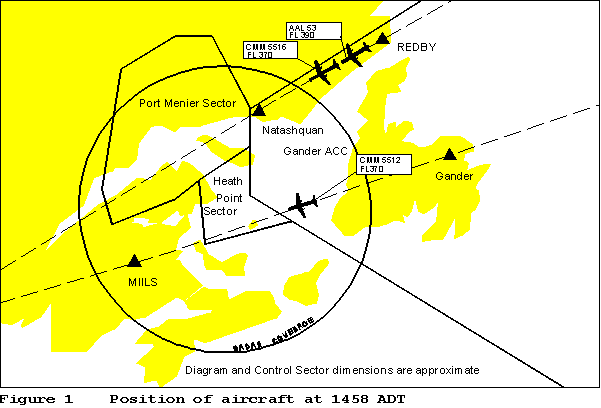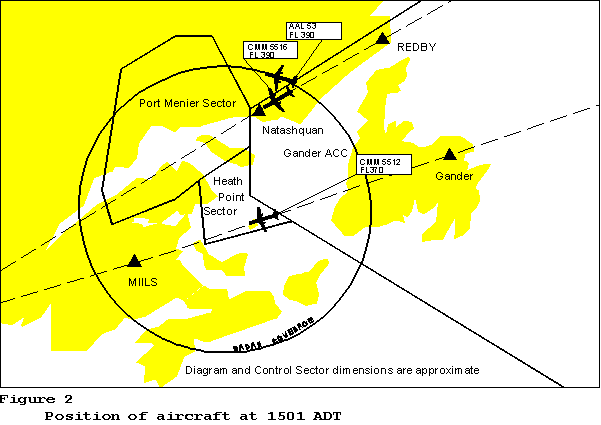Loss of separation
between
Canada 3000 BOEING Company 757 C-FOOH and
American Airlines Inc.
BOEING Company 767 N322AA
Natashquan, Québec
The Transportation Safety Board of Canada (TSB) investigated this occurrence for the purpose of advancing transportation safety. It is not the function of the Board to assign fault or determine civil or criminal liability. This report is not created for use in the context of legal, disciplinary or other proceedings. See Ownership and use of content. Masculine pronouns and position titles may be used to signify all genders to comply with the Canadian Transportation Accident Investigation and Safety Board Act (S.C. 1989, c. 3).
Summary
Factual information
Elite 5512 and Elite 5516 were both in the same Gander ACC sector, monitoring the same frequency. A review of the Gander ACC communications tape indicated that the Gander controller instructed Elite 5512 to contact Moncton ACC on frequency 132.8 MHz. The first officer of Elite 5516 responded quickly, said "28 thanks" and switched to Moncton on 132.8 MHz. An aircraft's identification or call-sign must be included in any radio transmission. The crew of Elite 5512 had not heard nor acknowledged the instruction for them to contact Moncton on 132.8 MHz.
Elite 5516 contacted the Moncton ACC controller on 132.8 MHz, and the first officer requested and received clearance to climb to FL390. During the hand-off from Gander ACC and the climb to FL390, the captain of Elite 5516 was not on the flight deck. The Canada 3000, Boeing 757, Standard Operating Procedures (SOP) manual requires that the other flight crew member confirm important directions, such as altitude changes, before they are complied with.
During the occurrence, the Moncton ACC Heath Point Sector was staffed with a controller trainee who was being supervised by an on-the-job instructor (OJI). The traffic volume during the occurrence was assessed as light with normal complexity. All equipment available and used by the controllers was functioning properly. The radar display was configured to display data tags only for the aircraft targets transiting through the Heath Point Sector, such as Elite 5512; the track for Elite 5516 and AAL 53 was outside the Heath Point sector.
The controller trainee had a target displayed as Elite 5512 on his radar when Elite 5516 established radio contact. The controller trainee asked Elite 5516 to confirm 5516 and not 5512. The pilot replied that their aircraft was Elite 5516, but there was another Elite, 5512, airborne as well. The controller trainee believed that the Elite 5512 target displayed on his radar was in fact Elite 5516 and the aircraft to which he was talking. He did not use any additional means to confirm aircraft identification. The controllers reported that sometimes the aircraft identification data displayed on the radar is erroneous.
The controller trainee checked that there was no traffic confliction for the radar target displaying the Elite 5512 data tag and cleared Elite 5516 to climb up to FL 390. During the period that the controller trainee accepted the hand-off and cleared Elite 5516 to climb, his OJI was momentarily distracted by a group of former Transport Canada employees that was being given a tour of the Moncton ACC. When the OJI returned his attention to what the controller trainee was doing, he noticed that the Elite 5512 target had not started to climb. The radar's "all" function was selected to display all aircraft targets, and the OJI saw the Elite 5516 target over Natashquan climbing. The OJI immediately instructed the controller trainee to clear Elite 5516 back down to FL 370, which he did.
In 1990, the Canadian Aviation Safety Board (CASB), as a result of a special investigation into air traffic control services, stated that inattention or lack of vigilance appears to be contributory in approximately 50 per cent of all ATS occurrences, and that these types of errors often happen during periods of light, non-complex traffic.
Analysis
The controller trainee's OJI was responsible for the ATC service being provided in the Heath Point sector of Moncton ACC. The presence of the tour group in the ACC diverted the OJI's attention, and he missed the trainee controller's identification of Elite 5512 as Elite 5516.
When the first officer of Elite 5516 told the controller trainee that there was another Elite, 5512, airborne, the controller should have been alerted to the possibility of an aircraft identification problem. The use of another means of aircraft identification, such as having the crew squawk ident on their transponder, would have revealed the discrepancy, and eliminated any doubt before issuing a clearance for the aircraft to climb. The controller trainee had experienced aircraft data errors on the radar display in the past, and he incorrectly assumed that the aircraft handed-off to him was the one displayed on his radar.
The traffic volume and complexity at the time of the occurrence was well within the capabilities of the controller trainee to handle. The OJI felt that constant monitoring of the controller trainee was not required and might possibly decrease his confidence. It is possible that the period of light, non-complex traffic contributed to a complacent attitude in both the OJI and his controller trainee.
The first officer of Elite 5516 should have transmitted the aircraft's full call sign when he acknowledged the Gander controller's instruction to change to Moncton Centre. The Gander controller probably would have heard the wrong aircraft identification, advised Elite 5516 of their error, and instructed the correct aircraft, Elite 5512, to contact Moncton ACC. Had the captain of Elite 5516 been present when the hand-off and clearance to climb were received, he may have detected the case of mistaken identity.
Findings
- Elite 5516 acknowledged and acted on ATC instructions to change to Moncton Centre that were directed to Elite 5512.
- The first officer of Elite 5516 did not use his aircraft's call sign when he acknowledged the hand-off to Moncton centre.
- The traffic volume during the occurrence was assessed as light with normal complexity.
- The controller trainee did not confirm that the aircraft he saw on his radar, Elite 5512, was the aircraft with which he was communicating, Elite 5516.
- The controller trainee cleared Elite 5516 to climb when the aircraft was not in his area of control responsibility.
- A tour group in the Moncton centre distracted the OJI from his responsibility to properly monitor the controller trainee.
Causes and contributing factors
A loss of separation occurred because the OJI was not properly monitoring the controller trainee when the trainee cleared Elite 5516 to climb. Contributing to the occurrence were the following: the trainee did not properly identify the aircraft; the first officer of Elite 5516 used improper phraseology; and, the Gander controller did not confirm the identification of the aircraft that read back the clearance.
This report concludes the Transportation Safety Board's investigation into this occurrence. Consequently, the Board, consisting of Chairperson, John W. Stants, and members Zita Brunet and Maurice Harquail, authorized the release of this report on .

